Introduction to the ATAD2 Bromodomain
The ATPase family, AAA-domain containing protein 2 (ATAD2) is a nuclear co-regulator protein with an ATPase domain and a bromodomain, whose function remains largely undefined. AAA ATPase superfamily members are associated with varied cellular activities in which the energy from ATP is harnessed to produce a mechanical force for molecular remodeling. Bromodomains are known to bind acetyl-lysines and are thought to regulate protein interactions and in addition to gene transcription. Studies have shown ATAD2 (also called ANCCA) to play a role in estrogen and androgen receptor signaling and also to act as a co-activator of the MYC oncogene (1, 2). ATAD2 is found overexpressed in numerous types of cancer and is correlated with poor patient prognosis (1, 3). This makes ATAD2 an attractive target for novel cancer therapeutics. A general schematic of the ATAD2 protein is given in Figure 1.
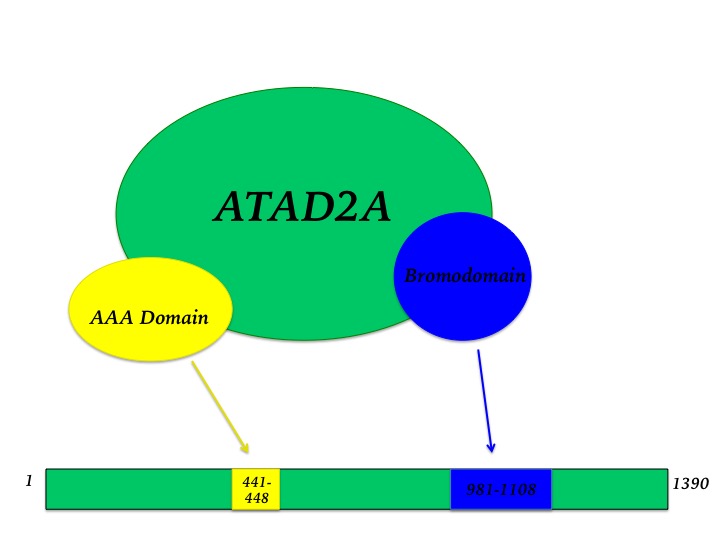
Figure 1. Schematic representation of ATAD2 with the two separate domains shown in yellow (AAA Domain) and blue (Bromodomain).
Structural Analysis
The ATAD2 bromodomain contains the canonical left-handed bundle of 4 alpha helices denoted aZ, aA, aB, and aC. These maintain two variable loops, the ZA loop and the BC loop. Variations in these loops confer specificity for different acetylated lysine modifications. The protein sequence is given in Figure 3. The bromodomain is contained within residues 981-1108 of the entire protein sequence of ATAD2. It is composed of 128 amino acid residues, and includes all of the twenty common amino acids but tryptophan, and has a mass of 15212.24 Daltons. The ATAD2 bromodomain belongs to the bromodomain superfamily, as identified by CATH, SCOP, and within the BLAST search. The apo structure of the ATAD2 bromodomain (PDBID: 3dai) was solved with X-ray crystallography by Filipakopoulos et al. in 2012 and reveals the tertiary structure as described above and seen on this page in Figure 2.
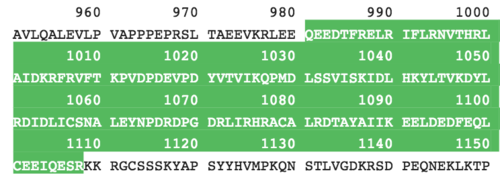
Figure 3. Amino acid sequence of the ATAD2 bromodomain is highlighted in green.
Relation to other Family IV Bromodomains
Family IV bromodomains include ATAD2, ATAD2B, BRPF1, BRPF1B, BRPF3, BRD7, BRD1, and BRD9. When performing an alignment of each member of the Family IV bromodomains, there is distinct similarity in structure between them. Despite this structural similarity, the difference within the binidng pocket confer specificity and allow each to bind their own distinct set of histone marks. The alignment was performed in PyMol and is shown in Figure 4. Given in Table 1 are the RMS values of this alignment, showing that the paralog, ATAD2B has the greatest similarity to the ATAD2 bromodomain and this is followed by BRD9 and so on.
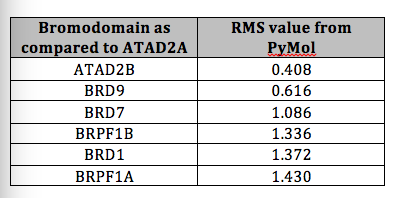
Table 1: RMS values from PyMol of each of the Family IV bromdomains (except BRPF3, for which no structure currently exists) when aligned with the ATAD2 bromodomain.
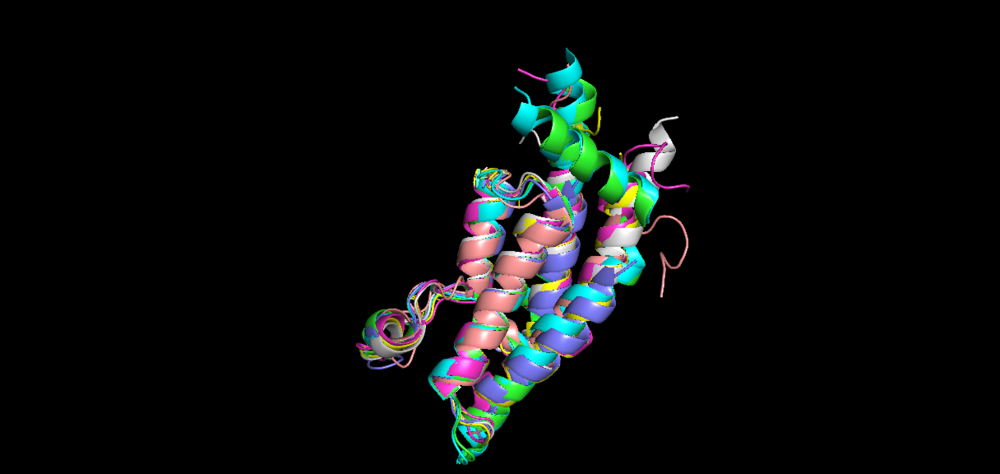
Figure 4. Alignment of all Family IV apo bromodomain structures, except BRPF3 for which no structure is deposited currently with the ATAD2 bromodomain.
Acetylated-Lysine Recognition
The ATAD2 bromodomain recognizes several acetylated lysines on the histone tail of H4. Among these are H4K5ac (PDBID: 4TT2), H4K12ac (PDBID: 4QUT), and more recently the diacetylated H4K5acK12ac (No structure deposited) (4, 5, 6). The ATAD2 bromodomain also makes contact with H3K14ac (PDBID: 4TT4), but the crystal structure shows an interaction outside of the bromodomain binding pocket. Several residues are involved in ligand coordination. These include the conserved TYR1021, ASN1064, and the gatekeeper residue ILE1074. Also involved are members of the RVF shelf, ARG1007, VAL1008, and PHE1009 which provide additional selectivity for acetylated ligands alongside the gatekeeper residue. TYR1021 and ASN1064 are responsible for coordination of the ligands. Of note, TYR1021 interacts with ligands through a water molecule. Differences in these residues across bromodomains confer specificity of individual bromodomains. These residues are shown highlighted in Figure 5. RVF shelf is orange, conserved tyrosine is yellow, the conserved asparagine is blue, and the gatekeeper residue is shown in purple. This shows how the residues meet to form the binding pocket of the bromodomain. The specific connections are shown in Figure 6, of the ATAD2 structure (green) complexed with H4K5ac colored (cyan). Colors of individual residues are conserved from Figure 5.
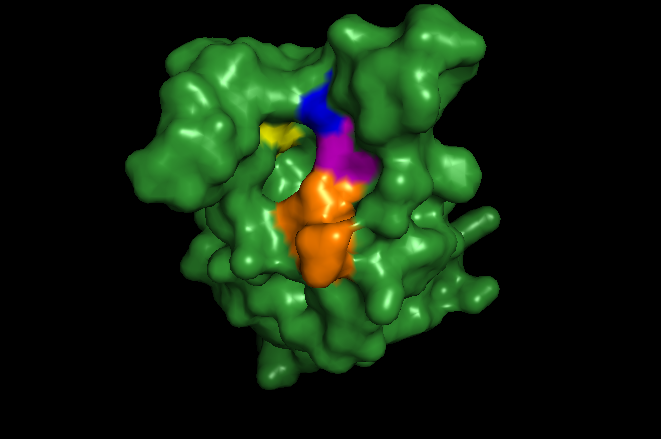
Figure 5. Surface structure of the ATAD2 bromodomain with key residues involved in recognition highlighted. the RVF shelf is highlighted in orange, the conserved asparagine in blue, the gatekeeper isoleucine in purple, and the tyrosine in yellow.
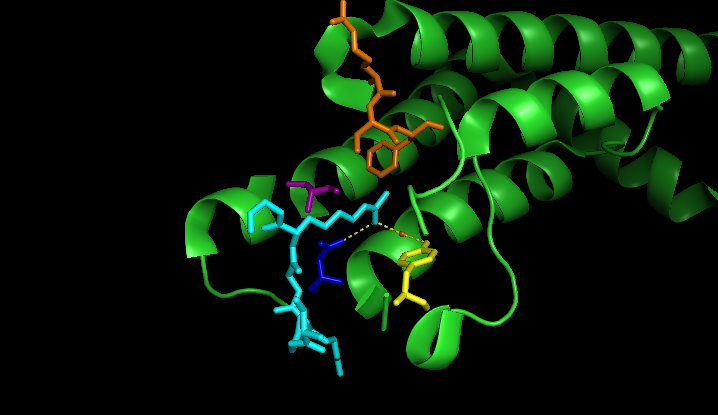
Figure 6. From structure of the ATAD2 bromodomain with histone ligand H4K5ac (PDBID:4TT2): Binding pocket of the ATAD2 bromodomain with same highlighted residues as Figure 5. Notice the bonding between the aspargine and the ligand, as well as the tyrosine's interaction through water.
Function of ATAD2
ATAD2 functions as a transcriptional co-regulator and chromatin remodeling protein, regulating chromatin structure and function. More recently, ATAD2 is proposed to act as a reader of newly synthesized diacetylated histone marks and to function as a cofactor of DNA polymerase to aid in replication (6). ATAD2 is required for gene response to androgens and responds to estrogen as well as being recruited by the active estrogen receptor-alpha (ERα) (7, 8). E2 factor genes (E2F) also require ATAD2 to function. Aside from mammals, little is known about its function in multicellular eukaryotes. Outside of its normal roles, ATAD2 is found upregulated in cancers and interacts with oncogenes MYC and ACTR (AIB1, SRC-3) (2, 8).
Findings in Cancer
ATAD2 has been found overexpressed in various types of cancer, including, but not limited to, breast, prostate, lung, gastric, and renal (9, 10, 11, 12). ATAD2’s expression is amplified through a positive feedback loop in cancer. ATAD2 interacts with estrogen and androgen receptors, namely ERα, E2F, and AR, which in turn will increase ATAD2 expression to overexpress the gene (7, 8). Cancers will activate this gene systematically. Correlations with poor prognosis and survival rates make ATAD2 a novel marker. This relation to cancer makes ATAD2, namely the bromodomain, which guides the rest of the protein to specific marks, a novel therapeutic target. There has been discussion though that simple inhibition of the bromodomain may not be enough to be a therapy. The destruction of the entire ATAD2 protein however, would theoretically be the solution.
ATAD2 bromodomain as a target for cancer therapy
Several inhibitors have been designed over the last few years for the ATAD2 bromodomain, but there has been marginal success because of the bromodomain’s characterization as “difficult to drug” (13). Mentionable efforts have come from the MD Anderson cancer center and GlaxoSmithKline, which have produced compounds with sub 100nM potency and greater than 100-fold specificity over the BET bromodomains. There are still issues with non-selectivity and cell permeability, however. MD Anderson has produced two compounds (Compounds 1 and 2) that have an isoxazole base (4). GlaxoSmithKline has gone through a long refinement process to produce GSK8814 (Compound 16) (14). This has a naphthyridone base and a replacement of a CF2 group for the sulfone found in the previous compound because it was not well tolerated in an area of lipophilic residues.
More recently, a group from Bayer has produced a new inhibitor that has a novel mechanism of action and structure in comparison to current inhibitors. BAY-850 comes from formyl acid derivatives, and induces dimerization of the protein to prevent interaction with acetylated histones (15).
There is hope for these compounds to lead to more specific and permeable drug candidates, but in the meantime they can be used as probes to determine ATAD2 function and involvement in cell systems. These compounds are shown in Figure 7.
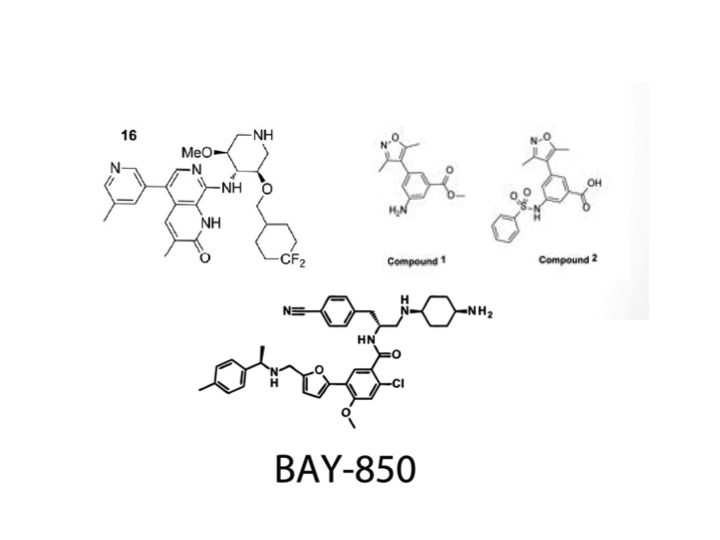
Figure 7. Structures of the four tightly-binding inhibitors for the ATAD2 bromodomain, Compound 16 from GlaxoSmithKline, Compounds 1 and 2 from the MD Anderson Cancer Center, and BAY-850 from Bayer.
Conservation
ATAD2 and homologs are found within species from yeast up on to humans. A BLAST search reveals the ATAD2 bromodomain to be conserved 100% in several organisms outside of humans, including donkeys, Przewalski's horse, tree shrews, new and old world monkeys, baboons, gibbons, bonobos, gorillas, orangutans, chimpanzees, deer mice, aardvarks, thirteen-lined ground squirrels, desert woodrats, kangaroo rats, gerbils, marmots, pikas, and beavers. A one-residue gap starts appearing with sea otters, certain bats, pandas, polar bears, dogs, cats, leopards, mouflons, goats, zebus, tigers, hamsters, cheetahs, elephants, deer, horses, camels, and whales. 98% matches are seen in sheep and galagos.
The ATPase domain is conserved across species, including yeast, zebrafish, roundworms, and humans, and it is found within all kingdoms in many different proteins and roles (16). Highest conservation of ATAD2 is specifically found within the ATPase and bromodomain domains. There have been many studies with Yta7, a yeast ortholog of ATAD2, in which findings may suggest possible roles for the human protein. There is still a lot to learn about this protein.
References
1. Caron C, Lestrat C, Marsal S, Escoffier E, Curtet S, Virolle V, Barbry P, Debernardi A, Brambilla C, Brambilla E, Rousseaux S, Khochbin S. 2010. Functional characterization of ATAD2 as a new cancer/testis factor and a predictor of poor prognosis in breast and lung cancers. Oncogene 29(37):5171-5181.
2. Ciro M, Prosperini E, Quarto M, Grazini U, Walfridsson J, McBlane F et al. (2009). ATAD2 Is a Novel Cofactor for MYC, Overexpressed and Amplified in Aggressive Tumors. Cancer Res 69: 8491–8498.
3. Urbanucci A, Barfeld SJ, Kytota V, Itkonen HM, Coleman IM, Vodak D, et al.. Androgen Receptor Deregulation Drives Bromodomain-Mediated Chromatin Alterations in Prostate Cancer. Cell Reports 2017; 19.
4. Poncet-Montange G, Zhan Y, Bardenhagen JP, Petrocchi A, Leo E, Shi X, Lee GRt, Leonard PG, Geck Do MK, Cardozo MG, Andersen JN, Palmer WS, Jones P, Ladbury JE. 2015. Observed bromodomain flexibilityreveals histone peptide- and small molecule ligand-compatible forms of ATAD2. Biochem J 466(2):337-346.
5. Morozumi Y, Boussouar F, Tan M, Chaikuad A, Jamshidikia M, Colak G, He H, Nie L, Petosa C, de Dieuleveult M, Curtet S, Vitte AL, Rabatel C, Debernardi A, Cosset FL, Verhoeyen E, Emadali A, Schweifer N, Gianni D, Gut M, Guardiola P, Rousseaux S, Gerard M, Knapp S, Zhao Y, Khochbin S. 2015. Atad2 is a generalist facilitator of chromatin dynamics in embryonic stem cells. Journal of molecular cell biology.
6. Koo SJ, Fernandez-Montalvan AE, Badock V, Ott CJ, Holton SJ, von Ahsen O, Toedling J, Vittori S, Bradner JE, Gorjanacz M. 2016. ATAD2 is an epigenetic reader of newly synthesized histone marks during DNA replication. Oncotarget.
7. J.X. Zou, L. Guo, A.S. Revenko, C.G. Tepper, A.T. Gemo, H.J. Kung, H.W. Chen, Androgen-induced coactivator ANCCA mediates specific androgen receptor signaling in prostate cancer, Cancer Res. 69 (2009) 3339–3346.
8. J.X. Zou, A.S. Revenko, L.B. Li, A.T. Gemo, H.W. Chen, ANCCA, an estrogen-regulated AAA+ ATPase coactivator for ERalpha, is required for coregulator occupancy and chromatin modification, Proc. Natl. Acad. Sci. U. S. A. 104 (2007) 18067–18072.
9. Altintas DM, Shukla MS, Goutte-Gattat D, Angelov D, Rouault JP, Dimitrov S, Samarut J. 2012. Direct cooperation between androgen receptor and E2F1 reveals a common regulation mechanism for androgen-responsive genes in prostate cells. Molecular endocrinology 26(9):1531-1541.
10. Z. Duan, J.X. Zou, P. Yang, Y. Wang, A.D. Borowsky, A.C. Gao, H.W. Chen, Developmental and androgenic regulation of chromatin regulators EZH2 and ANCCA/ATAD2
in the prostate Via MLL histone methylase complex, Prostate 73 (2013) 455–466.
11. Hong S, Bi M, Chen S, Zhao P, Li B, Sun D, and Tai J. MicroRNA-520f suppresses growth of gastric carcinoma cells by target ATPase family AAA domain-containing protein 2 (ATAD2). Neoplasma 2016; 63(6).
12. Chen D, Maruschke M, Hakenberg O, Zimmermann W, Stief CG, Buchner A. TOP2A, HELLS, ATAD2, and TET3 Are Novel Prognostic Markers in Renal Cell Carcinoma. Elsevier Basic and Translational Science 2017; 265(1).
13. Vukovic S, Brennan PE, Huggins DJ. Exploring the role of water in molecular recognition: predicting protein ligandability using a combinatorial search of surface hydration sites. J Phys Condens Matter 2016; 28.
14. Bamborough P, Chung CW, Demont EH, Furze RC, Bannister AJ, Che KH, Diallo H, Douault C, Grandi P, Kouzarides T, Michon AM, Mitchell DJ, Prinjha RK, Rau C, Robson S, Sheppard RJ, Upton R, Watson RJ. 2016. A Chemical Probe for the ATAD2 Bromodomain. Angewandte Chemie 55(38):11382-11386.
15. Fernandez-Montalvan AE, Berger M, Kuropka B, Koo SJ, Badock V, Weiske J et al. Isoform-Selective ATAD2 Chemical Probe with Novel Chemical Structure and Unusual Mode of Action. ACS Chemical Biology 2017.
16. Cattaneo M., Morozumi Y., Perazza D. et al. Lessons from yeast on emerging roles of the ATAD2 protein family in gene regulation and genome organization. Mol. Cells 37, (2014) 851–856.







